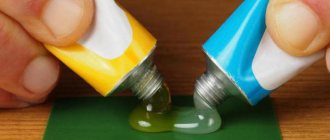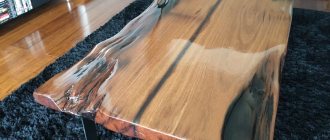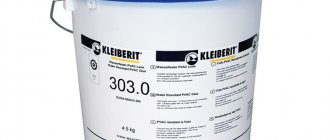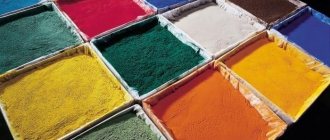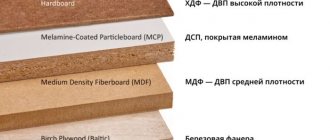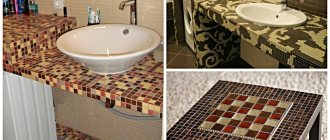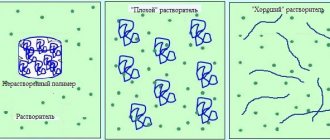Epoxy and polyester resins, the differences of which we will consider in this article, belong to the class of thermosets. This means that after the solidification process they can no longer be returned to a liquid state. Both compositions have different characteristics, which determines their scope of application. To understand the purpose of these materials, it is useful to read the overview of polyester and epoxy resins.
Epoxy resin
Epoxy is a material of synthetic origin. In its pure form, it is unsuitable for use, since it is not capable of turning into a solid state on its own. To harden, a special hardener is added to the epoxy resin in the required proportion.
To use it correctly, you need to know the pros and cons of epoxy resin. This type of resin is valued for its strength characteristics. It is resistant to aggressive chemical compounds such as acids and alkalis. The advantages of epoxy include: moderate shrinkage, high wear resistance, and excellent strength. The hardening process occurs over a wide range of temperatures, but the recommended range in everyday life is from +18 to +25 degrees. The hot curing method is used to produce high-strength products that can withstand extreme loads.
This type of resin is used both in industry and at home. The scope of their use is becoming wider thanks to the creation of new compositions with optimized properties. By mixing different types of epoxy resins and hardeners, it is possible to obtain a final product with completely different characteristics.
Characteristics
In its working form, polyester resin visually looks like a thick, viscous, transparent, colorless or yellow liquid. When the hardener begins to act in its composition, it becomes cloudy, becomes jelly-like, then rubbery, and finally hardens and remains in this state.
There are saturated and unsaturated resins; working with the latter does not require special conditions or high room temperature.
An important positive quality of unsaturated polyester resin is its versatility. Due to the fact that it can be worked with at least at room temperature, and it does not emit harmful by-products, it is used both in industry and in everyday life.
After curing, the polyester resin acquires the following properties:
Low thermal conductivity - can act as a heat insulator in electrical applications.
Dielectric properties - can be used as an electrical insulator in electrical applications.
Resistance to mechanical stress and mechanical load is weak - there is a high risk of cracks and delamination due to damage, stretching, and fractures.
Resistance to ultraviolet radiation (UV) and unchanged optical characteristics - the resin does not deteriorate when exposed to sunlight, does not become cloudy or change color.
Resistance to chemicals - the resin can be exposed to any chemicals and aggressive environments.
Weak adhesion - do not use polyester as an adhesive or when connecting products to each other.
Significant shrinkage - cured resin shrinks, so it should not be immediately coated with varnish or paint, and also used in cases where high precision of product parameters is required.
Moisture resistance - the resin is susceptible to water filtration and is not suitable for applications where absolute water resistance is required.
It should be noted that polyester resin is very durable and has a long service life without loss of its qualities, it is not afraid of temperature changes and can be used in any temperature range in domestic conditions. In addition, it is not at risk of boiling during the curing process under high heat, its polymerization speed is much higher (only a few hours), and its cost is several times lower - compared to epoxy resin. However, polymerization produces a strong odor, which epoxy does not have.
From a safety point of view, polyester resin, being in a liquid state, is potentially dangerous to human and animal health due to the presence of styrene (a toxic carcinogenic substance) in its composition, as well as other flammable and flammable components, and although after curing it does not emit harmful substances into the environment, but is still not recommended for use in the food industry due to its unproven environmental friendliness.
Application of epoxy resin
Epoxy resin is primarily used as a material for gluing surfaces: wood, leather, metal and other non-porous. This composition is in demand in electronics, mechanical engineering and aviation. Fiberglass, which is actively used in construction, is also made from epoxy. The resin is used for waterproofing floors and walls, including external ones. Finished fiberglass products after grinding and additional processing are popular in decorating interiors.
Repair of fiberglass body parts
Fiberglass has proven itself to be a reliable and practical material. Many automakers make from it not only decorative elements, but also non-load-bearing parts of the body (fenders, hood). Such elements are not subject to corrosion, but they have to be glued together or cracks repaired even more often than metal ones. Repair is advisable in the sense that even with significant damage, it is possible to restore the element to its previous shape.
Fiberglass impregnated with epoxy resin will retain its original shape. If you have a suitable matrix, you can independently produce body parts. However, such a matrix is difficult to produce, so many owners who decide to rely on their own strength restore parts “by hand,” allowing for significant errors.
Here, aesthetics are compensated by a small repair budget, which is why the use of epoxy in working with fiberglass still remains popular.
The work algorithm remains virtually unchanged. In exactly the same way as for metal structures, a patch is made from fiberglass. But when restoring a damaged part of a part, this patch is given a certain shape. The advantage of the material allows the frozen frame to be processed, puttyed and painted. Experienced craftsmen do this so skillfully that the result does not always differ from the factory stamp.
Useful to know > What primer is made based on epoxy resin and where it is used
Hardener for epoxy resin
The epoxy material consists of two components, after mixing which the polymerization process begins. The component that causes epoxy resin to harden is called a hardener. Depending on the use of different resins and hardeners, completely different epoxy mixtures can be obtained.
The proportion of hardener in the composition can be different and depends mainly on the brand of resin. The polymerization reaction of epoxy resin is irreversible, that is, it is not possible to melt an already hardened material.
It is a mistake to believe that if the amount of hardener is too high, hardening will occur faster. An effective way to speed up the process is to increase the temperature of the mixture. Increasing the operating temperature by 10 degrees allows you to speed up the process by 3 times. Special components are commercially available for these purposes. There are also epoxy mixtures that harden at low temperatures.
Incorrect selection of the amount of hardener has a detrimental effect on the quality of the finished product. First of all, its strength and resistance to chemicals decreases. If there is a small amount of hardener, the consistency of the part becomes sticky; if there is an excess, the polymer is released on the surface of the material. The most common resin/hardener ratios are 1/2 or 1/1. Before mixing, it is recommended to read the instructions for the correct ratio of components.
Epoxy anticorrosive
Areas most exposed to moisture and reagents are coated with a special anti-corrosion compound. The properties of epoxy resin allow it to be used as an anticorrosive agent. But epoxy anti-corrosion compounds differ from polishes. They should protect the car body not for several months, but for several years.
In addition to epoxy resin, the anticorrosive composition includes other substances, the list of which depends on the place of work. For example, for the underbody of a car it is recommended to use pastes containing wax and bitumen. The metal of the wheel arches is subject to constant bombardment of small stones, so rubber is added to the anti-corrosion compound. External body elements (lower parts of doors and sills) are treated with resin with aluminum powder or zinc paste. Almost all brands have one drawback - the likelihood of delamination at low temperatures. The applicability of such an anticorrosive agent depends on climatic conditions.
Useful to know > How to pour epoxy resin correctly, which polymer to choose for pouring a thick or thin layer
Polyester resin
This resin is formed during the processing of special-purpose alcohols. The basis of the material is polyester. To speed up the hardening process, specialized solvents and inhibitors are used. Depending on the scope of application of the material, it may have different structure and properties. The resulting product requires additional processing aimed at increasing protection from water and ultraviolet radiation. The additional coating also enhances the strength characteristics of the product. Polyester resin, unlike epoxy resin, is characterized by low mechanical properties. But at the same time, polyester is distinguished by its low price, due to which the material is more popular.
Such resins are actively used in the construction of buildings, in the automotive industry, shipbuilding and in the production of containers for chemical compositions. Polyester components, when mixed with glass, form highly durable compounds. Thanks to this, the resulting material is used in the manufacture of canopies, roofs for buildings and lighting fixtures.
Polyester resin is also included in artificial stone. Plastic made using this component is used in the production of window sills, shower cabins, partitions and decorative elements. Polyester resins, unlike epoxy resins, are easy to paint.
Areas of use
Due to its low cost, polyester resin is actively used both in industry and in everyday life.
In the construction industry, it is used in the manufacture of compositions for sealing seams and joints in finishing, in the production of window sills, lightweight roofing elements and cornices. Transparent polyester resin for casting is excellent for the production of translucent structures: canopies, canopies. It is also used to make transparent shower doors and bathroom partitions.
Transparency is also why it is chosen for the production of compositions for creating self-leveling floors and podiums.
As a binder and stabilizing substance, polyester is added to various impregnations and used in the manufacture of building fiber and particle board materials based on wood and asbestos cement.
Also in construction and interior and exterior design, polyester is used as a basis in the manufacture of finishing materials and countertops made of artificial stone. The mold is filled with various fillers in the form of crumbs (mineral, marble, metal, rubber, granite, cement, gypsum) and the voids are filled with resin and dyes (liquid glass can be added). Next, the product is dried in a drying cabinet. Since polyester resin does not have high strength characteristics, glass mat coated with a special binder is placed as a substrate under the product - it holds the entire product together.
Unfortunately, the moisture resistance and mechanical properties of polyester resin are insufficient, so its use in the plumbing industry and shipbuilding is limited. If products are made with its participation that are constantly in contact with water, and also experience significant loads, including fracture, and are subject to deformation, then their service life will be short. For example, bathtubs, toilets, shower trays, basins, boat hulls and larger vessels will be at risk of osmosis (bubbling) on the surface (on the outer decorative gelcoat coating) due to the ability of polyester to filter water molecules through itself - that is, it can allow moisture to pass through to the laminate of a fiberglass product and thereby contribute to its destruction. Therefore, this resin is most often used for the manufacture of individual parts of cars, snowmobiles, ATVs, motorcycles, airplanes and other equipment.
In mechanical engineering, in particular the automotive industry and body repair, it is actively used in the manufacture of bumpers, spoilers, body kits and other body elements that are not subject to mechanical stress and do not perform a load-bearing function.
Despite all its shortcomings in terms of strength and moisture resistance, polyester resin perfectly performs its functions as a cast insulator in the fields of electronics, electrical engineering and radio engineering. In lighting devices, on microcircuits and in radio components, polyester can be found in the form of spots of the compound.
In addition, it perfectly performs the function of a polymerizing hardening component in varnishes, paints, adhesives, mastics, putties, sealants, primers and putties.
Since polyester resin does not react with chemicals, it has been used in the chemical industry in the manufacture of pipes for the distillation of chemicals, including oil and petroleum products.
Among other things, it has become a common component in plastics: honeycomb plastics, plastics.
A successful application for polyester resin is in the fields of art, costume jewelry, and haberdashery. With its help, a wide variety of cheap and lightweight decorative items, jewelry and useful household items such as toiletries are created.
And finally, polyester serves as a cheap binder in glass mats, holding small short pieces of fiberglass together, turning them into a non-woven fabric.
What is the difference?
When asking the question: “Which is better, polyester or epoxy?”, you need to understand why and where the resin is needed. Both materials have their pros and cons, and the final choice depends on the conditions of use as well as the type of surface the resin will be applied to.
Epoxy has a higher cost, but is more durable. Possessing excellent adhesive properties, it firmly connects surfaces of different structures. Epoxy resin differs from the polyester product due to its low shrinkage, better mechanical characteristics, and wear resistance.
At the same time, unlike polyester, epoxy takes longer to harden, which slows down the process of manufacturing parts from this material. Working with such a resin requires increased safety measures: when working with liquid material, gloves are required; when handling a solid product, a respirator is required. The danger is not so much the resin itself as the components used to give it a solid state. When hardening under high temperature conditions, there is a chance of losing the viscosity of the material, which creates additional difficulties in work.
Which resin is better, epoxy or polyester? Reviews say that in most cases the former is used in the form of glue, since its properties are much higher than those of polyester-based material. In other situations, it seems more rational to use a polyester resin, which, firstly, will save money and, secondly, will simplify the work.
Other types of resins
There are other types of materials that can replace those described above. They are less popular, but still used in industry.
Vinylester resins
These are modern types of materials, the principle of formation of which is similar to that of polyester. Vinyl ester resins are more durable - this property is given to them by the epoxy molecules included in their composition. Shrinkage is higher than that of epoxy, but lower than that of polyester.
Other material characteristics:
- does not allow microcracks to form,
- increases adhesion to surfaces,
- has high water-resistant properties.
Unfortunately, such materials contain harmful substances (styrenes), although a number of modern modifications do not include these elements. The downside is poor polymerization at normal temperatures. The price of the products is high, slightly lower than the cost of epoxy resins.
During operation, care must be taken: when applied to dissimilar surfaces, there is a risk of detachment of the outer part of the coating. The material shows the best adhesion to fiberglass, while its adhesion to carbon fiber and Kevlar is worse.
Bakelite resin
Bakelite is a product of polycondensation of phenol with formaldehyde with the participation of an alkaline catalyst. The material belongs to thermosets and is formed at the initial stage of production of phenol-formaldehyde resin. In appearance, bakelite resin is a viscous liquid of light yellow, dark yellow color.
The material is used as a connecting link in the production of abrasive products of hot, cold pressing and rolling. The property of bakelite to transform into an insoluble form when heated for a long time is used for the preparation of plastics. Alcohol solutions are used as varnishes.
Material properties:
- high resistance to friction, pressure, shock,
- poor thermal conductivity,
- easy processing on machines,
- electrical insulating qualities,
- no damage from alkalis and cold acids,
- resistance to temperatures up to +300 degrees.
Epoxy vinyl ester resins
Such materials are characterized by the highest chemical resistance and can protect products from corrosion. They are especially popular in production, where the anti-corrosion properties of fiberglass are needed.
Thanks to these qualities, epoxy vinyl ester resins can be used in a number of industries:
- chemical,
- cellulose,
- semiconductor,
- energy,
- metalworking,
- petrochemical production,
- release of medicines,
- recycling.
The application of chemical-resistant resins makes the products protected from solvents, oxidizing agents, chlorides, and alkalis. Some types of epoxy vinyl ester resins can withstand temperatures up to +315 degrees, but most of them can be used for a long time up to +175 degrees. The service life of fiberglass is several decades. The cost of the material is moderate - lower than that of epoxy resins.
Isophthalic resin
This type of material belongs to polyesters, the only difference is in the specifics of the production process. Isophthalic resin differs from standard polyester molecular weight and structure. This determines slightly different properties of the finished fiberglass.
Isophthalic materials have a complex structure. Their other properties:
- high impact strength,
- excellent adhesion to glass fibers,
- ability to withstand large static and dynamic loads,
- low water absorption,
- can be applied manually and by spraying.
Orthophthalic resins
Compared to isophthalic resins, orthophthalic resins have a less complex structure. The composition contains special additives that improve environmental performance and reduce the harmfulness of fumes. Some do not contain styrene at all and are considered safe.
A number of resins contain paraffin and are intended to create a surface film on the laminate. Orthophthalic resins harden quickly and need to be worked with within a short period of time.
Advantages of using polyester
Polyester does not emit toxic elements, is easy to use, and special knowledge is not required to work with it. The composition is used to coat various surfaces followed by treatment with a strength-increasing agent. In terms of adhesive properties, polyester is significantly inferior to epoxy, and it is irrational to use it for gluing surfaces. It is not suitable as a material for decorative products, as it has low mechanical properties. When mixing the polyester composition, a small amount of catalyst is used. The material hardens quickly, within 2-3 hours.
The finished part is elastic and resistant to bending. The disadvantage of products made from polyester resin is flammability. Do not apply polyester resin to a product made of epoxy. To repair a product made from epoxy material, it is better to use the same material.
Do you need a primer?
Another question that has generated a lot of controversy. Is it necessary to prime the metal before laying putty? The fact is that manufacturers have also introduced many controversial issues into this topic. Compositions are constantly changing in the process of improvement. Therefore, you can find radically different recommendations.
Let's trust the instructions on the packaging here too. Do as the manufacturer recommends. But if we consider general cases, it is worth highlighting the following points:
Draw your attention to. Acid primer cannot be used under polyester putty. Materials enter into a chemical reaction with each other. Paint on teak areas will not last long. And also you can’t put polyester on thermoplastic materials.
Analysis of manufacturers' recommendations allowed us to compile a list of surfaces on which polyester putty can be applied:
How to properly prepare the surface
The resin should only be applied to a previously prepared surface. The first step is degreasing using a solvent. After removing dirt and grease, the sanding process is carried out. The top layer is removed from the surface of the material using sandpaper or a special tool. Then the dust removal process is carried out. After this, you can begin applying the working component.
Polyethylene terephthalate resins
Polyethylene terephthalate resins are obtained as a result of the condensation reaction of terephthalic (paraphthalic) acid and ethylene glycol.
The process of resin formation proceeds according to the scheme shown in Fig. 6.
Rice. 6.
A feature of this process is that terephthalic acid does not melt or dissolve in ethylene glycol, and the reaction takes place in a heterogeneous environment. Therefore, to speed up the reaction process and avoid overheating of the mass, vigorous stirring and gradual introduction of terephthalic acid into the reaction are necessary.
Ethylene glycol and part of terephthalic acid are loaded into the reactor, which are heated to 200–210 °C with vigorous stirring. Then the remaining amount of acid is gradually added.
Further condensation is carried out at 200–250 °C with systematic control of the acid number of the resin. The synthesis of resins is carried out in devices similar to those used to produce glyphthalic resins.
An industrial method for producing polyethylene terephthalate resin consists of transesterification of dimethyl ester of terephthalic acid with ethylene glycol, followed by condensation of low molecular weight esters resulting from transesterification according to the scheme shown in Fig. 7.
Rice. 7.
The resulting polyethylene terephthalate resins have a linear structure, a high degree of crystallinity and a high melting point (220–240 °C).
These resins are widely used for the manufacture of artificial fibers and films: lavsan (ex-USSR), terylene (England), hostaphan (Germany). Films and fibers made from this resin have high mechanical strength, elasticity and resistance to solvents. The electrical properties of lavsan films are high, and in terms of heat resistance they belong to insulation class “E”.
However, due to its thermoplastic properties, polyethylene terephthalate cannot be used without additional processing for the manufacture of varnishes used for enameling wires, gluing mica, impregnating the windings of electrical machines, etc.
To make varnishes, it is necessary to obtain a polyethylene terephthalate resin with lateral branched groups, giving a three-dimensional spatial polymer. For this purpose, along with glycols, polyhydric alcohols (glycerol) are also used. Additional condensation of the resin is carried out either by heating the resin under vacuum or in a solvent, for example, tricresol. In this case, a varnish of 45% concentration in a solvent (tricresol) is obtained, which is used for enameling wire.
Safety precautions
In order not to cause harm to health when working with resins and hardeners, it is necessary to take all precautions to the maximum. Failure to follow these simple rules can result in skin damage, burns, or lung problems when working with epoxy or polyester resins. Safety precautions when working with chemicals:
- The use of containers intended for cooking is prohibited.
- All manipulations must be carried out in special clothing and gloves. Before carrying out work, apply protective cream to your hands. Finished products are polished using a respirator and special glasses.
- If resin comes into contact with your skin, you should immediately wash it with soap or clean it with alcohol.
Handling of epoxy components should be carried out in a well-ventilated area.
Manufacturing
During the distillation of petroleum, products such as benzene, ethylene and propylene are formed. Based on them, anhydrides, polybasic acids and glycols are produced. When all components are combined, the base composition of polyester is formed. It is also called base resin. To obtain the finished polyester resin, the base composition is mixed with a solvent.
In principle, after their interaction, a composition with characteristic properties is obtained. It goes on sale and can be used in production. However, it is possible for the process to move to the second stage. Various additives are added to the resin. Their content and dosage depends on the purpose. Examples include plasticizers, pigments and binders.
Once the polyester resin is on sale, there is a limited time available for sales. The reason is that the polymerization and curing process begins spontaneously.
Over time, the quality of the main cast gradually deteriorates. To increase shelf life, you have to lower the temperature, so it is recommended to store the resin in refrigerators.
Before direct use, all components are warmed to room temperature, the main composition is mixed with a hardener, activator and catalyst according to the manufacturer's instructions. After mixing all the components, the resin acquires characteristic indicators of moisture resistance, density and strength. Single-component materials are available on sale, which means that additional components will have to be purchased separately.
Popular brands
On the building materials market you can find polyester resins from domestic and imported suppliers. Due to the high consumption, the material is packaged in various containers with a capacity of 1 liter and above.
- Neon S-1. Neon S-1 resin is presented by Rempolymer. It is positioned as a pre-accelerated thixotropic polyester, which is known to consumers due to its low viscosity. The main component is based on styrene, but high quality fillers are used. It is secretly believed that this brand of resin is excellent for car tuning, as well as for repairing boats and boats. The suitability time for the composition after preparation is 15 minutes. Complete curing occurs in 45 minutes.
- Reoflex Repair Resin or Reflex is known as a universal product for surface lamination. The resin belongs to the class of orthophthalic polymers and is characterized by a low styrene content. Can be used for all types of primary coating, as it has high adhesion to metals, glass, wood and paints. The Reflex polyester resin layer can withstand significant loads, temperature changes, and is also resistant to oil-containing products. The addition of a plasticizer transforms the resin into a material suitable for sealing metals. The brand is in demand by car mechanics, as it is used in the repair of plastic elements.
- Norsodyne O-12335 AL. Norsodyne O-12335 AL casting resin does not lose its optical properties when exposed to light. Its resistance to ultraviolet radiation is widely used in finishing works. The pre-accelerated resin takes on a gelatinous consistency within 20 minutes. A special hardener is produced for it - Butanox. The share of hardener is 0.3-2% of the volume of the base composition. Norsodyne resin exhibits adhesive properties even at a temperature of 15°C degrees, while the lower limit for other models is 20-22°C degrees.
- Novol Plus 720. High-quality material with average performance - Novol Plus 720 resin. It is used as glue when working with rubber products, as a binding component for plastic, and also as a sealant, and holes can be sealed in metal, glass, plastic and wood. The strength of polyester allows it to be used to strengthen boat hulls, and resin is used as an additive even when repairing car bodies.
Butanox hardener is added to component “A” (basic composition). Its exact quantity is determined by the manufacturer. The average hardener share is 2.5%. Cured polyester is processable. It can be sanded and coated with varnish or paint.
